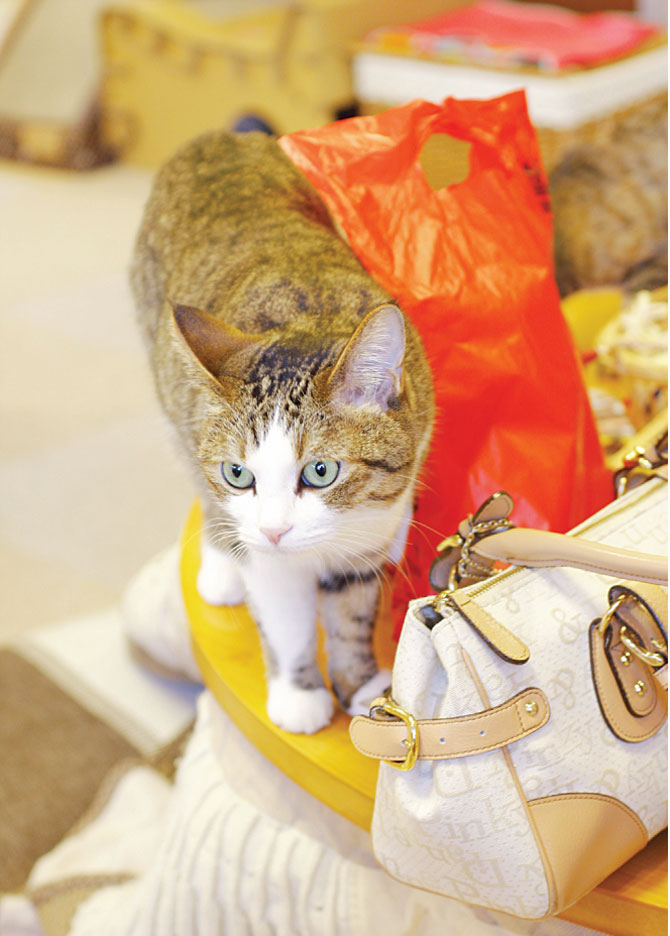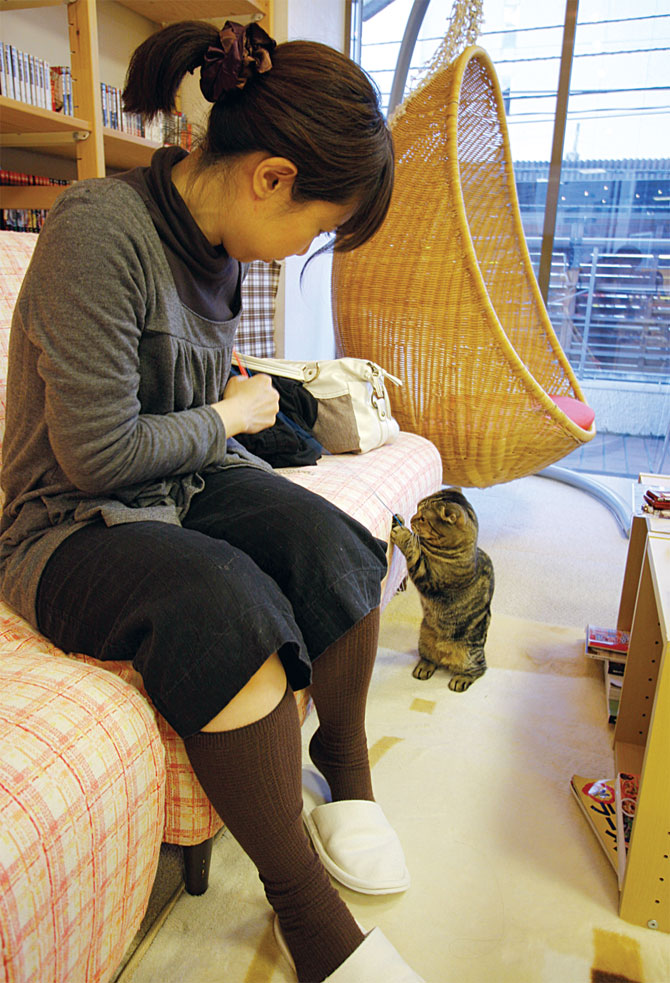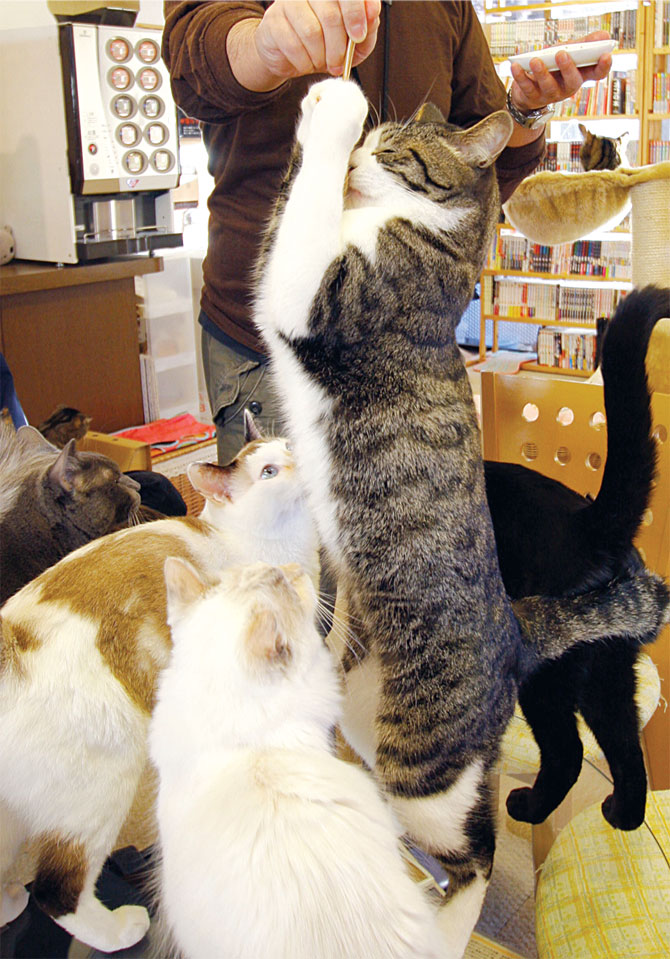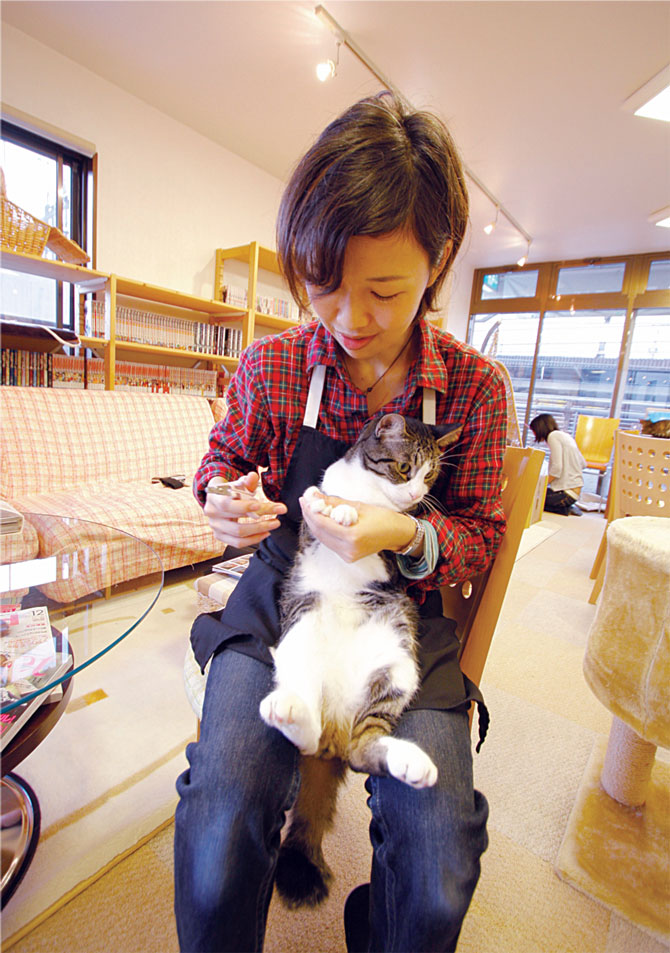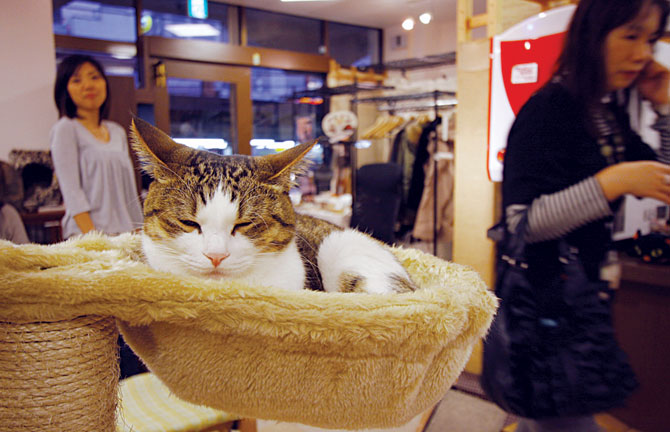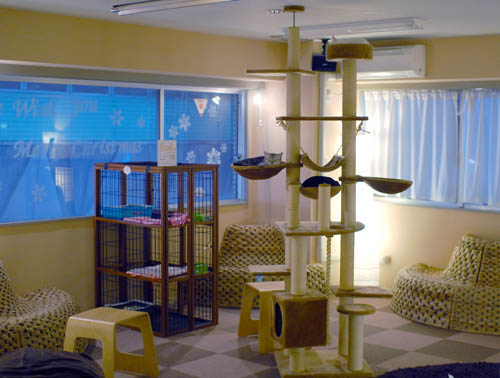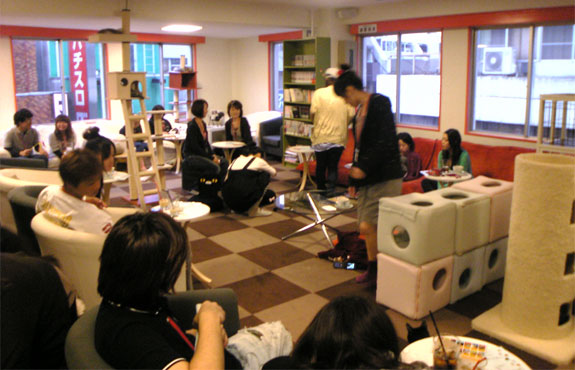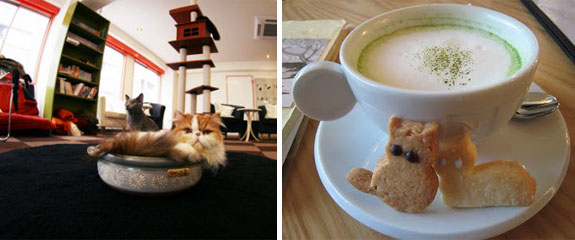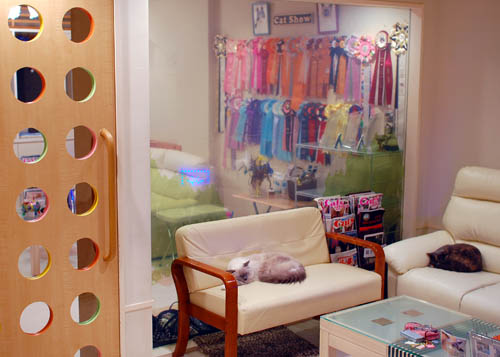Thursday, September 30, 2010
Wednesday, September 29, 2010
Cat Cafes
 |
| Chamamo Cat Cafe Mascot |
All sorts of cafes can be found in Japan, even a cat one. Nush, not a cafe for cats, but a cafe for cat-lovers who come to socialize not just with each other but also the cafe’s coterie of resident cats. For a small fee, cat-lovers can come and have some quality time with the adorable kitties, without the long term commitment of owning one. You can feed, pet, and groom them just like a real owner.
It seems this type of cafes are quite huge in Japan right now, and it is understandable considering the Japanese lifestyle. Many people live in very small apartments and are rarely allowed to have pets by their strict landlords. Under the stressful and isolated environment lived specially in urban centers many lonely singles don't even have a pet to comfort them during troubled times.
As the name suggests, these are coffee shops where cat lovers go to sip overpriced lattes and hang out with an adorable smoosh pile of kitties. In the past five years, exactly 79 such cafés have popped up all over Japan. What’s weird is that the café cats aren’t expensive pedigreed felines like Persians or those other ones with the funny bendy ears, they’re just the everyday mixed breeds you might find in the back lot of your local supermarket, cats who, in the immortal words of Brian Setzer, “slink down the alley, looking for a fight/Howling to the moonlight on a hot summer night.” Likewise, in the past few years, there’s been an explosion of photo books and DVDs featuring average-joe cats. If people are so fascinated by what are essentially domesticated alley cats, why don’t they just swoop one up from the legions of strays all over Japan and take them home? I’ll tell you why: because landlords in Japan are dicks.
Thirty-eight-year-old Norimasa Hanada, the owner of Neko no mise (Shop of Cats), Tokyo’s first-ever cat café, explains the problem: “Most Japanese rental apartments prohibit pets. The only ones that allow them are condominium apartments for families. This means that young, single-dwelling workers in their 20s and 30s can’t even think about getting any pets, despite the fact that they’re stressed out and are seeking comfort and companionship of some kind.”
It makes sense, then, that most cat-café fans are relatively young. More than 30 customers shuffled into and out of Neko no mise during the four hours I recently spent there, and apart from one lady in her 50s, all the other patrons were in their 20s or 30s (most of them female, with only three guys spotted the entire time). Another contributing factor to the cat-café trend is that Japanese people are chronically shy, to the extent that many can’t even hold a decent conversation about the weather with a stranger. The wordless, tactile communication of kitty cats is a great source of comfort for these high-strung, antisocial urbanites.
At Neko no mise, a few sofas, chairs, and tables were scattered throughout the café, which emanated a relaxing, feminine atmosphere complete with soft music. One wall was lined with a bookshelf full of hundreds of manga books. Apparently there are 14 resident cats at Neko no mise, and because it’s winter in Tokyo right now, most were huddled under the kotatsu (a traditional Japanese low table with an electric heater on the underside). Since the cats are obviously the kings of the café (and they know it), they seemed more arrogant than I’m used to. Some of them were skittish and jumped around every time a new person came in or walked out. I got the impression that unless you’re willing to stay for the long haul, befriending a café cat is trickier than desired, especially for an establishment that makes money off the illusion that patrons will be guaranteed some pussy lovin’.
There are a few different types of cat-café customers. Newcomers will be so swept up in the distinct atmosphere that they will just sit there stunned. It looked as if most of them had never had a pet cat or even touched one before and it seemed like they were struggling to come to terms with the unpredictable behavior of real cats while their fantasies of docile, purring balls of love were being shot to hell. In an hour’s stay, most could only manage to touch a passing cat just once. Many customers seemed like the shy, meek, silent type who were in need of a hug or two. Since these sorts don’t have the courage to go up to a cat and play with it themselves, they would read a book and sip coffee while they patiently hoped for a cat to come closer. It broke my heart.
Those who came in groups were generally cheerful and talked a lot, using the café as a place to catch up with friends. The cat factor was a bonus for them, and they grabbed the cat toys lying around and played with the cats quite successfully. The couples that I saw were either in new relationships or were still in the friendship stage, and were using the cats to bridge the awkward distance between them.
While I sipped my coffee in a room full of cats and cat groupies, I could slowly feel the soothing effects of the kitty café wash over me. Before I knew it, I was smiling for no reason and was so at ease that my eyes started to droop in a sort of happy stupor. Others must have been feeling the same numbing effects because occasionally the room full of people would fall silent as they stared at the cats’ every move.
Most customers stayed for at least one hour, but apparently some fanatics can last more than six hours. Norimasa told me that “while the average stay is an hour and a half, some regulars take a sick day from work and stay all day. They say that they’re about to buckle under the stress of their workload and need some time out. Some regulars come four or five times a week, while those who have become so mentally drained from work that they have taken an extended leave from their jobs come every day, seeking comfort and healing.”
Cat cafés generally charge a time-based fee. Neko no mise charges $1.50 every ten minutes ($9 an hour), and $21.50 for a special three-hour plan. Might sound like they’re overcharging, but maintaining a clean, dreamy cat environment ain’t cheap. The only way for cat cafés to survive is for them to maintain a high turnover rate and keep away the cheapskates who will otherwise undoubtedly stay for hours on end, nursing a single cup of coffee. Sadly, this also means that the regulars who stay for six hours end up paying more than $42 just to stroke some fur.
There’s a Japanese legend that says that cats become popular every time there’s a recession in this country, and it’s true that there’s been a huge boom in cat and cat-related-merchandise sales these past few years. Something about those pointy ears and tiny paws has a calming effect on the human mind. Or perhaps it’s the traditional Japanese culture of forcing people to behave like herds of sheep and act appropriately by carefully judging the vibe of every situation (what the Japanese literally call “reading the air”) that makes the independent, freedom-loving cat the perfect target of obsession. I know I’m making this all sound pretty sad, but like most cute things, it’s best not to think about it too much. Just stare into the hypnotizing eyes of the pretty kitties and let your troubles fall away. Purr.Read more at Viceland
Here's some cat cafes in Tokyo that you can visit ^^
Nekorobi ( Ikebukuro )
The welcoming staff and softly lit, comfortable atmosphere make Nekorobi a popular destination. So popular, in fact, customers may encounter a wait on weekends. For Y1000, you'll get an hour with the cats, unlimited drinks from the vending machine (coffee, cocoa, royal milk tea, etc.), and complimentary cookies.Nekorobi
You can use the Nintendo Wii or surf the Internet, but most people opt for a long play session with one of the eleven cuddly cats, most of whom can be found lounging on the tall cat tower, nestled into a cushy beanbag, or sharpening their claws on wicker seats that look like giant sombreros.
The clientele is a mix of couples, women, and men of all ages. Although some of the cats were purchased for the cafe, several were rescued or adopted. The cats have free reign of the space, but cages are there for troublemakers. The list of rules in Japanese and English ensures that guests stay out of trouble as well.
6228-0646
Ikebukuro / Cat cafe
Higashi-Ikebukuro 1-28-1, Tact T-O Bldg 3F. Open 11am-11pm daily.
Open on Sundays
Website: http://www.nekorobi.jp/english/
Punyan ( Takadanobaba )
If you're in the mood to snuggle up to a sleeping kitty, this seriously chill cat lounge is the place for you. Billowy Southeast Asian fabrics hang from the ceiling, filtering the light, while soothing music plays in the background. It's Y1000 for the first hour (Y300 for another 30 minutes) plus one drink.Punyan
3203-7441
Takadanobaba / Cat cafe
Takadanobaba 1-17-16, Star Plaza 6F. Open 11am-8pm daily.
Open on Sundays
Jalala ( Takadanobaba )
Get ready for romper-room feline fun - high-speed chases, tails whipping through the air - at this lively spot in Takadanobaba. The cafe's second branch (the original Neko Jalala is in Akihabara) houses twelve friendly kitties, who are allowed to roam free at all hours: cages are nowhere in sight.Jalala
The space and the level of activity bring to mind a kindergarten classroom. Bright orange paw prints cover the walls, colorful cushions dot the floor, and tree stumps do double duty as seats for the customers and launching pads for the cats.
Y500 will get you thirty minutes of playtime; after that it's Y150 for every additional ten minutes. Drinks are available from Y300 - four kinds of coffee, six flavored teas, and four herbal teas as well as juices and soft drinks. For Y200, you can buy cat treats and a furry entourage. Reservations are recommended on weekends.
6380-3325
Takadanobaba / Cat cafe
Takadanobaba 1-6-15, Arai Bldg 4F. Open noon-7:30pm (LO) daily.
Open on Sundays
Website: http://www.nekojalala.com/
Chamamo ( Harajuku )
A bit smaller than the average cat cafe, Chamamo makes up for it with a good location (in central Harajuku) and a great view of Tokyo. They have nine cats "on staff" and charge Y500 for the first thirty minutes.Chamamo
3498-2294
Harajuku / Cat cafe
Jingumae 6-5-6, Sanpo Sogo Bldg 5F. Open 11am-11pm daily.
Open on Sundays
Website: http://chamamo.wilbo.jp/
Neko no Maho ( Gotanda )
If you happen to miss the last train in Gotanda, Neko no Maho can provide an alternative to the manga cafes: this cat cafe stays open until 5:30am. In the afternoon, it's Y250 per fifteen minutes, or Y900 per hour. Food and drinks, both alcoholic and non-alcoholic (Y500-), are available in the dining section downstairs.Neko no Maho
3868-2504
Gotanda / Cat cafe
Nishi-Gotanda 8-4-15, Tokyo Morris Bldg #2, 7/8F. [next to Osaki-Hirokoji station, or 4 min. from Gotanda Sta.] Open 11:30am-5:30am. Closed Wed, 3rd Thurs.
Open till late
Open on Sundays
Website: http://www.nekomaho.com/
Calico ( Kichijoji )
One of Tokyo's largest cat cafes, with 28 felines (and one dog) to hang out with. Y900 for one hour; soft drinks are Y100-200.Calico
0422-29-8353
Kichijoji / Cat cafe
Kichijoji Minamicho 1-5-7, Yuki Bldg 4F. Open 11am-10pm (LO) daily.
Open on Sundays
Website: http://catcafe.jp/
Curl Up Cafe ( Meguro-ku )
When they aren't modeling for magazines or winning prizes for best in show, the twelve cats at this friendly cafe can be found stretching out on the cream-colored leather couches or curled up in cat beds. The feline staff commutes with the owner every day. The cheerful interior, with its white walls and blond wooden surfaces, is brightly illuminated and immaculate.Curl Up Cafe
An array of hot and cold drinks - cappuccinos (Y600), specially blended floral-infusion teas (Y800) and fresh fruit smoothies (Y600) - are available, along with a few food items like pork fried rice (Y600) and Mexican jambalaya (Y700).
One drink is included in the entry fee - Y900 for half an hour or Y1200 for an hour. If you wish to extend your visit, it's Y500 for 30 minutes or Y800 for an hour.
5755-5393
Meguro-ku / Cat cafe
Haramachi 1-7-4. [1 min. from Nishi-Koyama station on the Meguro-sen, 3 stops S of Meguro] Open noon-8pm (11-7 Sat, Sun). Closed Mondays.
Open on Sundays
Website: http://curl-up.net/
Labels:
Japan


Tuesday, September 28, 2010
Hana Kogure
Hana Kogure has such a beautiful and pleasant voice aaw ~ <3
She will be giving two concerts soon in Portugal. You can find more details about it here and here. Enjoy~
She will be giving two concerts soon in Portugal. You can find more details about it here and here. Enjoy~
Monday, September 27, 2010
If I Bought A Doll
If someday i bring myself to buy a doll ( which i will surely do! ) i think me wants it to look something like this ^^
*nose bleed* Ahh ~
If you bought a doll how would you like it to be? Or if you is already having a doll then how is he/she? ^^
 |
| This lovely boy belongs to Colette Bennett |
*nose bleed* Ahh ~
If you bought a doll how would you like it to be? Or if you is already having a doll then how is he/she? ^^
Labels:
Dolls


Sunday, September 26, 2010
Kawaii Apparel
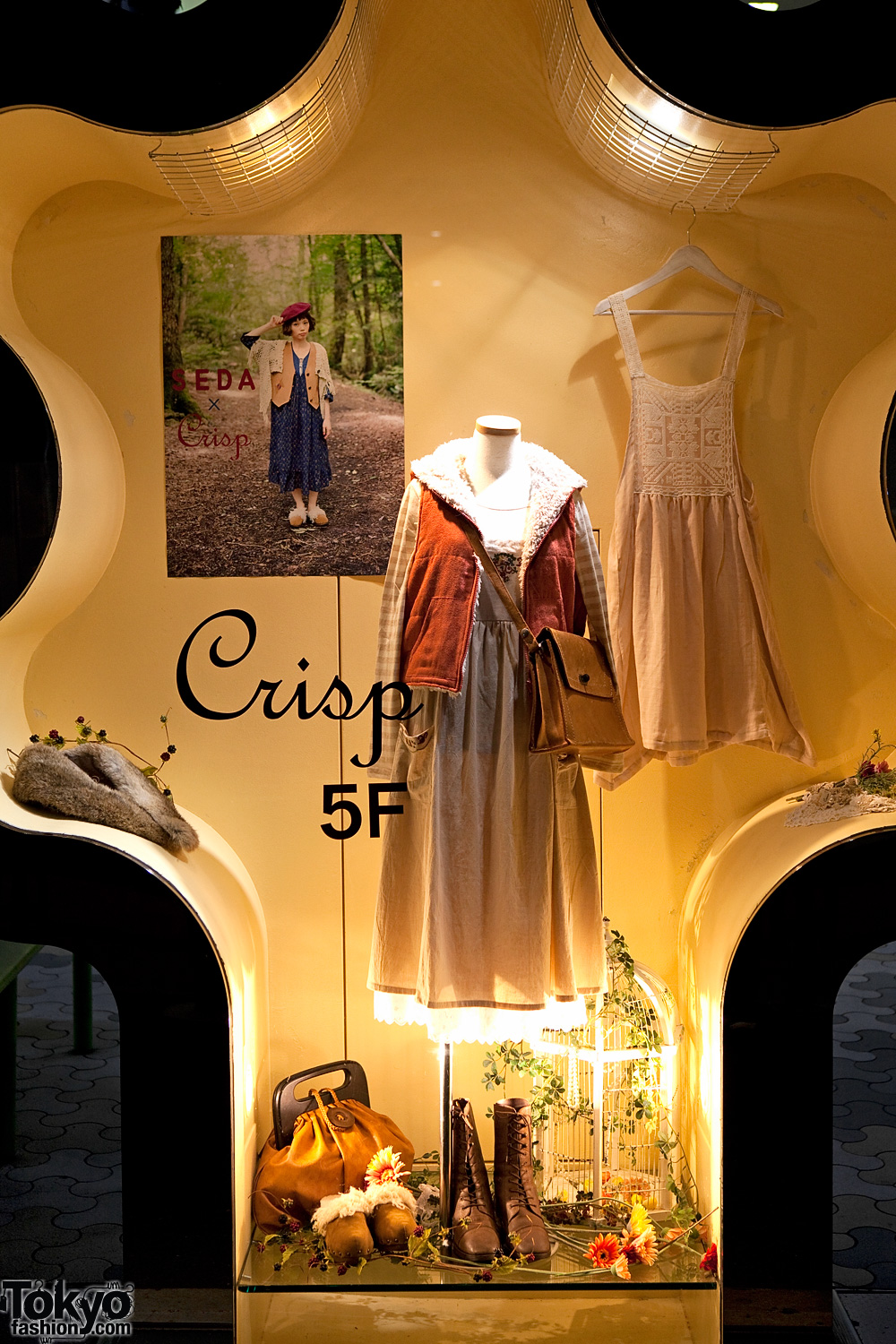 |
| Crisp in LaForet Harajuku |
I have to admit i really love these country and earthy styled clothes (:
 |
| Collect Point Harajuku |
What can i say about these uniform styled ones, they are always cute ^^
Kaichou wa Maid-sama Last Episode
Ahh~ TuT Gommen ne everyone, just watched the last episode of Kaichou wa Maid-sama and had an overdose of moe and kawaii, dammit my heart's racing xD Me is now having a lot of faith on the 2nd season! Heard it is already confirmed, just there isn't a release date yet, can't wait for it! ^^ If you still hasn't seen it then take a look, enjoy! ;)
Labels:
Anime


Saturday, September 25, 2010
Japanese Praxe
Seems Portuguese universities aren't the only places doing praxes. I was surprised to know than in Japan this kind of tradition also exists. 850,000 new Japanese employees, nicely dressed ( dark suit and tie ), met the usual opening practice on this fiscal year opening in Japan. In some cases they sang the Company hymn, in others they met other practices committed to freshmen on the labor market. In the image's case, they diligently polish their former bosses shoes. Excellent and clear symbol of how to progress in a professional career rapidly and successfully: polish the gloss from the chiefs shoes. To begin and to never forget.
Labels:
Japan


Friday, September 24, 2010
Monday, September 20, 2010
Asia Images | John Lander
Came across this wonderful website some time ago, it has a huuuuuge gallery of great pictures from all over Asia! Silly me wanted to see it all in one day but its just impossible xD Will leave you with some of my favorite ones of Japan. All pictures by freelance photographer John Lander.
Groups of choreographed dancers and musicians known as ren dance through the streets at summer festivals in Japan, typically accompanied by the shamisen lute, taiko drums, shinobue flute and the kane bell. Performers wear traditional obon dance costumes, or summer kimono, and chant and sing as they parade through the streets. Originally from Tokushima, Shikoku, its popularity has spread through Japan and is now a standard feature of summer festivals throughout the country.
Once the private domain of the silk baron Hara Sankei, one of Japan's most exquisite gardens was opened to the public in 1904. Hara wished to share the beauty of his bounty by opening up his grounds, surely one of the world's most beautiful examples of benevolent capitalism. The cherry blossoms in spring and maple leaves in autumn make Sankeien a favorite spot in Yokohama for residents and visitors alike. Besides the landmark three-storied pagoda, koi ponds, streams and an elegant feudal lord's residence, numerous tea houses are scattered through the expanse.
The dramatic torii of Itsukushima Shrine is one of Japan's most popular attractions. The gate has existed since 1168, though the current gate was reconstructed in 1875. Built of camphor wood and standing about 16 metres high the gate was built in a four legged style to provide additional stability. The gate only appears to be floating and only at high tide. When the tide is low the gate is surrounded by mud. Retaining the purity of the island is so important that no deaths or births were permitted in the area until quite recently.
Japanese festivals are traditional festive occasions. Some festivals have their roots in Chinese festivals but have undergone dramatic changes as they mixed with local customs. Matsuri is the Japanese word for a festival or holiday. In Japan, festivals are usually sponsored by a local shrine or temple, though they can be secular.
Shisendo is both a hermitage and garden in eastern Kyoto established by Jozen Ishikawa, a scholar and landscape architect. After he retired from samurai service he devoted the rest of his life to learning Chinese classics. When he was 59, he built what has come to be known as Shisendo. The main hall overlooks a garden covered in white sand surrounding a pond, encircled by landscaped shrubs.
Once the private domain of the silk baron Hara Sankei, one of Japan's most exquisite gardens was opened to the public in 1904. Hara wished to share the beauty of his bounty by opening up his grounds, surely one of the world's most beautiful examples of benevolent capitalism. The cherry blossoms in spring and maple leaves in autumn make Sankeien a favorite spot in Yokohama for residents and visitors alike. Besides the landmark three-storied pagoda, koi ponds, streams and an elegant feudal lord's residence, numerous tea houses are scattered through the expanse.
Labels:
Japan


Sunday, September 19, 2010
Subscribe to:
Posts (Atom)



